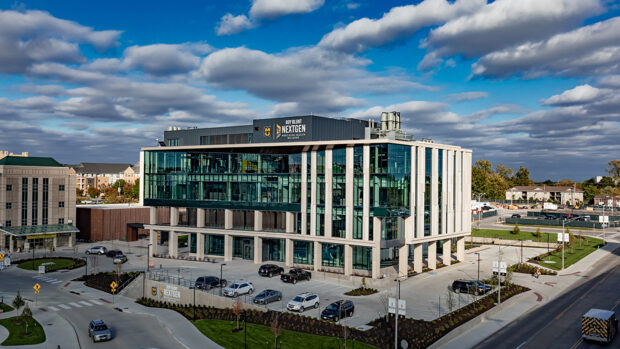HOME | ABOUT US | MEDIA KIT | CONTACT US | INQUIRE
HOME | ABOUT US | MEDIA KIT | CONTACT US | INQUIRE
Seismic shifts in health-care infrastructure bode well for Missouri residents.

PUBLISHED AUGUST 2023
Missouri has long been able to tout world-class health-care delivery. Over the past year, that world has been rocked by two major developments: One from inside the state’s borders and one adjacent.
Most recently was the announcement that two of the state’s most prominent providers—BJC Healthcare in St. Louis and Saint Luke’s Health System in Kansas City—would join forces as a single, $10 billion entity providing statewide services for 6.17 million residents.
The second development carries a more regional impact. Adjacent to the state line in Kansas City, The University of Kansas Cancer Center completed a two-decade journey that produced its prized designation as a Comprehensive Cancer Center, a level that the National Cancer Institutes have granted to fewer than 60 organizations in 36 states.
It’s the only comprehensive-level center in the Kansas City market and one of only two in the Missouri-Kansas region. The other? By happy coincidence, this road leads back to St. Louis and BJC’s Alvin J. Siteman Cancer Center.
Executives tied to both developments say that each will help elevate care and provide more focused research, yielding benefits that go beyond patient care and treatment, extending to the commercialization of drugs and medical devices.
U.S. News & World Report, in its annual rankings of the best hospitals in America, routinely includes BJC’s Barnes-Jewish Hospital in St. Louis among the Top 15, including health-care giants such as the Mayo Clinic, Cedars Sinai in Los Angeles, and Mass General in Boston.
While Barnes-Jewish stood out as the highest-ranking Missouri hospital, it had plenty of company in the magazine’s honor roll. Its new partner in Kansas City is recognized in the Top 25 for cardiology and heart surgery, as well as high-performing status in five specialties and 13 procedures. Children’s Mercy Kansas City also has a long history with the magazine’s ranking of pediatric hospitals in the U.S., having earned recognition in 10 separate care categories (with at least three Top 20 finishes) and a high-water ranking of No. 4 nationally in pediatric nephrology.
Combined, Missouri’s 83 acute-care hospitals admitted nearly 660,000 patients and produced 3.4 million patient days in 2022, generating more than $90.2 billion in patient revenue. They also accounted for more than 170,000 employees during the pandemic year of 2020, a figure that is expected to rise as the workforce reductions of that era begin to ebb.
Though straddled by two large health-care markets that draw from multiple states, Missouri has numerous regional and community hospitals, especially in the next-tier markets of Springfield and the Columbia-Jefferson City corridor, as well as sub-markets that include St. Joseph, Joplin, and Cape Girardeau.
The seven largest metropolitan areas are home to nearly 72 percent of the state’s residents, ensuring a significant majority of the population has access to acute care within their MSA, including 11,100 physicians and nearly 82,000 licensed nurses.
Among those medical facilities, the granddaddy of them all is Barnes-Jewish, the crown jewel in the BJC Health Care system and the biggest facility in the state, with 1,274 staffed beds. It has dominated health care delivery in St. Louis and the surrounding region since it was formed in 1966 with the merger of Barnes Hospital and Jewish Hospital.
BJC is just one pillar in a 186-acre health-care complex that covers 18 acres of Downtown St. Louis, an area designated the Washington University Medical Campus, and includes the Siteman Cancer Center and St. Louis Children’s Hospital.
Three major faith-based systems also stand out in Missouri health care: Ascension, with more than 150 hospitals nationwide; Ohio-based Mercy, which operates 25 hospitals (12 in Missouri) across a four-state region; and the Sisters of Saint Mary’s SSM Health, with 23 hospitals in Missouri, Illinois, Oklahoma and its headquarters state of Wisconsin.
Mercy Hospital in St. Louis, with nearly 860 beds, is the largest rival to Barnes-Jewish and adds to a highly competitive market for care delivery. SSM, which is aligned with Saint Louis University, brings 332 more beds to market.
In other parts of the state, CoxHealth has its biggest facility in Springfield, at 867 beds, and an important additional campus with 157 beds in Branson.
The Kansas City metropolitan region offers an even wider diversity of provider options, thanks to the population dynamics that differentiate it from St. Louis. The latter market has far more residents on the Missouri side of the Mississippi than their Illinois neighbors. Kansas City, by contrast, is divided almost equally by a state line, whether measured by population, wealth, or health-care assets.
Accordingly, there is considerably more cross-state movement between patients and providers than in St. Louis. And Kansas City is blessed with multiple major medical centers as well as teaching research and community hospitals. On the Missouri side, HCA Health Midwest and Saint Luke’s Health System have more than a dozen of those facilities combined.
The biggest of the systems is HCA Midwest Health, with nearly a dozen hospitals anchored by the 480-bed Research Medical Center complex. Saint Luke’s, with 422 beds, is the flagship of a system with facilities across the Kansas City area.
Anchoring health-care in central Missouri is the University of Missouri Health in Columbia, the teaching hospital affiliated with Mizzou. With 643 beds, it’s the state’s sixth-largest and includes the Ellis Fischel Cancer Center. To the northwest, the 352 beds at Mosaic Life Center’s main hospital in St. Joseph are just the start of that institution’s extensive reach across multiple counties to the north, a service territory bordering both Nebraska and Iowa.
Even in the rural areas of a state that spans 62,000 square miles, access to emergency medical services is often just minutes away. Air-ambulance heliports at more than 110 medical centers and community hospital locations serve more than 670,000 people who live in nearly 80 counties outside of MSA designation.